See the previous 1.2 changelog.
What's Changed?
This update is divided into two parts. First, we revamped our stereo sound testing to provide results that align with how you'll likely use your soundbar. Second, we improved our latency tests to be more consistent and relatable to what you'll experience with different audio formats in the real world. This article is only an overview of these changes, but if you're interested in learning more about our process, you'll want to check out our R&D article.
Here are the test groups impacted by this update:
|
Test Group |
Description |
|
Stereo Frequency Response |
|
|
Stereo Dynamics |
|
|
Stereo Total Harmonic Distortion |
|
|
Audio Latency: ARC (previously called Latency) |
|
|
Audio Latency: HDMI In |
|
|
Audio Latency: Optical |
|
Stereo Frequency Response
We've revamped this test to provide results that better align with how you'll actually use your soundbar. Increasingly, manufacturers recommend different sound settings or positioning to optimize their product's sound. Moving forward, we'll consider these recommendations when testing for stereo sound.
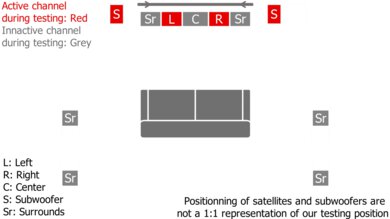
The Nakamichi Shockwafe Ultra 9.2Ch eARC is a great example of these changes in action. This unique soundbar comes with two subwoofers and four satellites. Above, you can see how we positioned those components in the past. You can also see that we tested the bar with only its right and left drivers active.
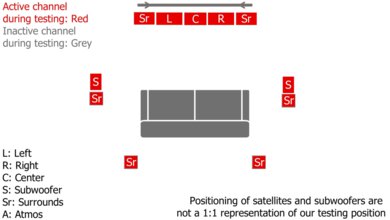
However, Nakamichi recommends different positioning for its subwoofers and satellites to optimize its sound. With their recommended sound settings, all channels are active with stereo content.
Stereo Dynamics
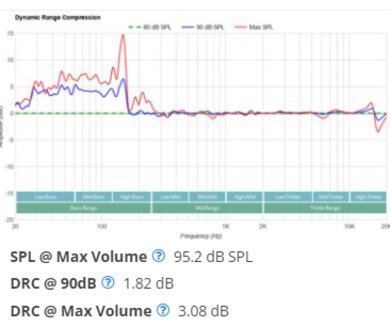
Previously, we tested a soundbar's dynamic range compression only at max volume. Not everyone will want to listen to their soundbar at such a loud volume, though, and there's still the potential for compression at lower volumes. We've added a test for dynamic range compression at 90 decibels to address this.
The Polk Audio MagniFi MAX SR is an example of a soundbar with much more compression when pushed to max volume. Comparing the red line on the graph (representing DRC @ Max Volume) with the blue line on the graph (DRC @ 90dB) shows how a lower listening volume improves the clarity of audio reproduction.
The SPL @ Max Volume measurement still comprises 60% of the total score for this box. The other 40% is divided between DRC @ 90dB (20%) and DRC at Max Volume (20%), so its performance at a more moderate volume is also taken into account.
You can learn more about stereo dynamics with our article here.
Stereo Total Harmonic Distortion
Our previous tests made it difficult to understand whether or not distortion was audible with real-life content. Unfortunately, this isn't always so simple to figure out. Even the type of content you listen to can impact whether you hear distortion. To avoid confusion, we'll remove this box for the time being. However, we plan to continue to look into this issue on our end and consider improvements for future test bench updates.
Audio Latency
The best way to get a sense of how we measured a soundbar's latency in the past is to watch the video below. We set up an iPhone in front of a TV, then recorded it as we played back a YouTube video designed to demonstrate the lag between the audio you hear and the visuals on screen.
This test measured AV synchronization error, which is best defined as the amount of audio latency minus the amount of video latency. It wasn't really clear how these measurements would play out in real life since video latency can vary depending on the display you use. To improve, we've designed a new methodology that tests audio latency instead—the time lag between when an audio stream is inputted and when audio plays on the speakers.
We'll continue to measure latency across different connection types, including ARC, HDMI In, and Optical, but now, each connection has its own separate test box. Also, we've expanded our tests to evaluate a soundbar's audio latency with various audio formats, such as Dolby Digital and Dolby Atmos, making finding results relevant to your usage easier. You can compare our previous tests with our expanded testing below.
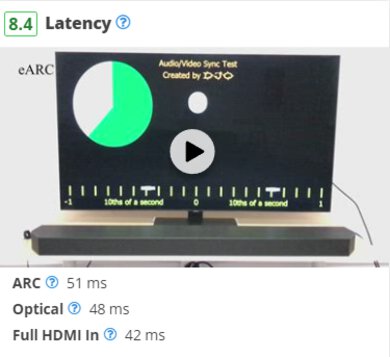
Our old tests measured AV synchronization error over three connection types. However, they only evaluated one type of audio format.
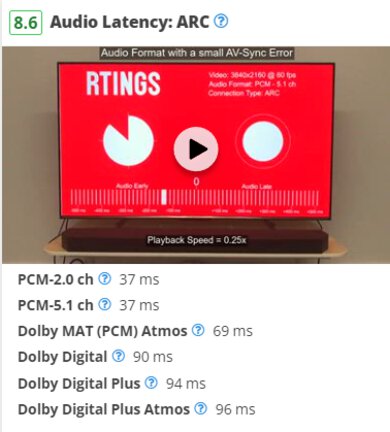
Our expanded tests measure audio latency over a variety of common audio formats. We've divided them into three boxes (ARC, HDMI In, and Optical) based on connection type. Above is a sample of an ARC box.
Scoring for these tests is based on how popular various audio formats are over the different connections. Unfortunately, the Murideo doesn't allow us to test for DTS formats, so we can't approximate the audio latency with these particular formats at this time.
To better understand how these measurements affect a soundbar's performance in real life, we also record videos designed to represent the AV synchronization error. Again, video latency varies depending on your display, so your real-world experience will depend. To account for this, we film both a low and high range of the AV synchronization error so you can get a sense of your likely experience at both ends of the spectrum.
What Do You Think?
Like our changes? Wish we did more? We're always interested in hearing your thoughts. Almost all of the changes made in this update were inspired by feedback from users like you. Let us know what you think in our forums.
53 Soundbars Updated
We have retested popular models. The test results for the following models have been converted to the new testing methodology. However, the text might be inconsistent with the new results.
- Bose Smart Soundbar 600
- Bose Smart Soundbar 700
- Bose Smart Soundbar 700 with Speakers + Bass Module
- Bose Smart Soundbar 900
- Bose Smart Soundbar 900 with Speakers + Bass Module
- Bose Smart Ultra Soundbar
- Bose Solo Soundbar Series II
- Bose TV Speaker
- Hisense AX5125H
- JBL Bar 1000
- JBL Bar 1300X
- JBL Bar 500
- Klipsch Cinema 1200
- LG S75QR
- LG S80QY
- LG S95QR
- LG SC9S
- Nakamichi Shockwafe Ultra 9.2 eARC
- onn. 42" 5.1. 2. Dolby Atmos Soundbar
- Polk Audio MagniFi MAX SR
- Polk Audio Signa S4
- Samsung HW-B550
- Samsung HW-B650
- Samsung HW-Q600C
- Samsung HW-Q60C
- Samsung HW-Q800B
- Samsung HW-Q800C
- Samsung HW-Q900C
- Samsung HW-Q930C
- Samsung HW-Q990B
- Samsung HW-Q990C
- Samsung HW-S60B
- Samsung HW-S800B
- Sennheiser AMBEO Soundbar Mini
- Sennheiser AMBEO Soundbar Plus
- Sonos Arc
- Sonos Arc with Sub + One SL Speakers
- Sonos Beam (Gen 2)
- Sonos Beam (Gen 2) with Sub Mini + One SL Speakers
- Sonos Ultimate Immersive Set with Arc
- Sony HT-A5000
- Sony HT-G700
- Sony HT-S100F
- Sony HT-S2000
- Sony HT-S400
- TCL Alto 8+
- Vizio Elevate
- Vizio M Series M213ad-K8
- Vizio M Series M512a-H6
- Vizio M Series M51a-H6
- Vizio M Series M51ax-J6
- Vizio V Series V51-H6
- Vizio V Series V51x-J6